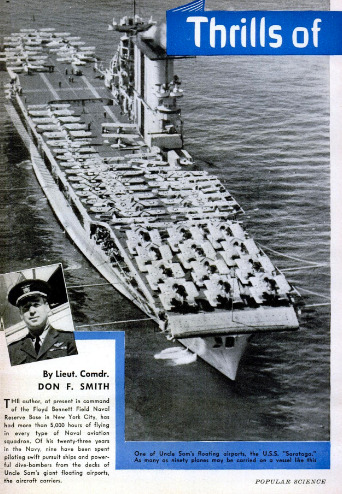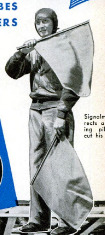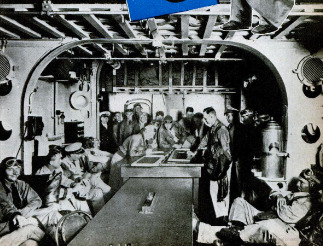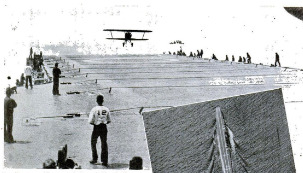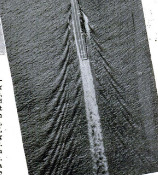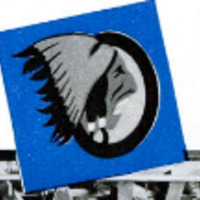-
Title (Dublin Core)
-
Thrills of the Flying Sailors
-
Article Title and/or Image Caption (Dublin Core)
-
Thrills of the Flying Sailors
-
extracted text (Extract Text)
-
THE reddish-brown deck streaks to the rear. Open wa-
ter flashes under your wings. You are climbing. That,
for a pilot aboard one of those hornets’ nests of the
sea, the aircraft carriers, is the beginning of adventure. [
One thrill which occurred off Panama, stands out in
my memory. 1 had lifted a TAM torpedo plane from the
million-dollar teakwood deck of the Saratoga. My mission
was simple. Twas to fly to another vessel, blank it off
with smoke screen, and return to my floating airport.
JustauT stantet down wlove my objective, thirty minutes:
later, a connection at the smoke
tank’ snapped. Choking, blind-
ing billows of chemical vapor
swirled around the plane.
Coughing and gasping, T
kicked over the rudder. The ship
skidded to the right; the trail of
vapor veered to the left. I gulped
In fresh air and straightened out. In an in-
stant, the white clouds of chemical fof
closed in again. For more than four minutes,
T kept skidding violently first to one side and
then to the other; bursting momentarily out
into fresh air and then disappearing again in
the billows of white vapor. Behind me,
stretching for more than a. mile and a half,
the trail of fog zigzagged like a writhing
snake. Observers thought I had gone crazy.
But those momentary emergence Into open
air kept me alive until the tank was empty.
That wouldn't happen again once In a
million times. Every safety aid is given the
carrier pilot. Equipment on such vessels is
the best In the world. And, when an emer-
gency such as T have described does occur
aloft, board of experts, later on, oes over
every detail of the experience to plan addi-
tional safeguards for the future.
During twenty-three years in the Navy,
including experience on many types of com.
batant ships and Yangtze River gunboats, T
have had about al the fun and adventure the
service has to offer. But the biggest kick of
all has been flying with the “carriers”
three of the largest in the world, the ploneer
Langley, the Saratoga, and the Lesington.
Even when the unexpected doesn't add to
the excitement, a flight from one of these
sea. airports ia thrilling enough In sels.
With brakes on and motor roaring, your
ship stands poised between twin yellow lines
running the length of the deck. You get the
signal, release your brakes, race down the
800 feat of teakwood that forms the runway,
and lft into the air. A moment later, an-
other plane follows you. Thus, in rapid suc.
consion, the sea hawks take wing. Between
seventy and ninety planes ride on one of
Uncle Sums large carriers. The smallest
are single-seat, high-speed scouting planes:
the largest, Douglas bombers.
Every flight from an aircraft carrier Is
‘made for some specific purpose. Like signal
practice In football, life aboard such a ship
sa succession of drills, & perpetual effort to
increase efficiency. Four times a year, sham
battles, or Navy games, are carried out at
sen with carrier pilots discovering and at-
tacking the “enemy.” The weeks between
are spent in radio drills, navigation study,
dive bombing, gunnery practice, homing
drill, and group exercises. Over and over
again, operations are repeated until they it
like cogs into a smooth working machine for
offense and defense.
For dive-bombing practice, paper bags of |
aluminum powder, tossed into the ocean, |
spread glittering, fifteen-foot disks on the |
water. These shining targets are visible at |
18,000 feet, an altitude from which the am- |
ple deck of the aircraft carrier appears no |
larger than a tiny piece of brown ribbon. As |
many as eight times in a single day, pilots |
will ‘make screeching, three-mile plunges
from the sky. The pull-out begins at about |
2,500 feet, just after the dummy bombs have
left the ship, and the plane levels out only |
1,000 feet or so above the water.
The landings provide most of the fireworks
on a floating airport. When planes are com- |
ing in, a special Diesel-powered whaleboat, |
holding emergency crews and a flight sur- |
geon, is slung over the side ready to go into |
action if a flyer is forced down in the water. |
Two destroyers always follow 1,000 yards |
apart in the wake of the carrier, also ready
for rescue work. And, on board, a special |
movie cameraman stands by, ready to film |
every landing that may end in a crack-up. |
Even the most trivial accident is recorded
for study. Pilots, at regular intervals, see |
“crash shows.” These reels, showing acci-
dents on board the various carriers, help |
them avoid making mistakes that have |
brought others to grief. |
Sometimes as many as seventy-ifour high-
speed ships will be wheeling about an air-
craft carrier, getting into the “landing
groove,” ready for coming aboard in quick
succession. When they do come in, they
land only a few seconds apart. This exhibi-
tion of precision flying is a stirring spectacle.
For the pilot, it provides a thrill that never
grows stale.
I have been through it more than 300
times. Once, off Hawaii, ground swells were
lifting and dropping the bow of the Lezing-
ton through a fifty-foot arc when I swooped
down for a sixty-seven-mile-an-hour land-
ing. Another time, the Saratoga was turn-
ing as well as steaming full speed ahead
when the engine of my torpedo plane sput-
tered and I had to sit down on the deck as
best I could. In normal landings, as well as
in take-offs, the aircraft carrier is running
at peak speed into the wind.
Just as the quarterback directs a football
team, so the signalman on the bridge of an
aircraft carrier directs the pilots in landing.
He is always a veteran flyer himself and he
studies the peculiarities of each of the pilots
on the carrier until he knows what he will do
in any kind of an emergency. With a yellow
flag in either hand, he “lands” the ships in
-
Contributor (Dublin Core)
-
Don F. Smith (article writer)
-
Language (Dublin Core)
-
eng
-
Date Issued (Dublin Core)
-
1940-07
-
pages (Bibliographic Ontology)
-
46-48, 216-217
-
Rights (Dublin Core)
-
Public domain
-
Archived by (Dublin Core)
-
Sami Akbiyik
-
Marco Bortolami (editor)
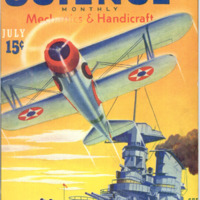 Popular Science Monthly, v. 137, n. 1, 1940
Popular Science Monthly, v. 137, n. 1, 1940

